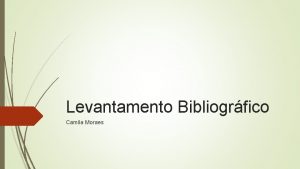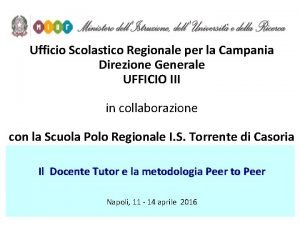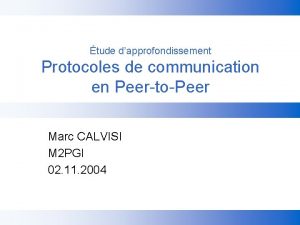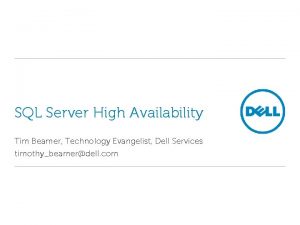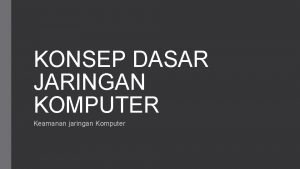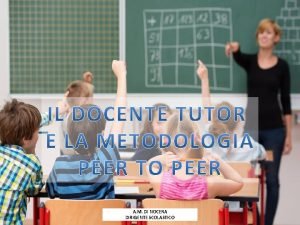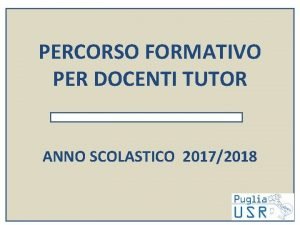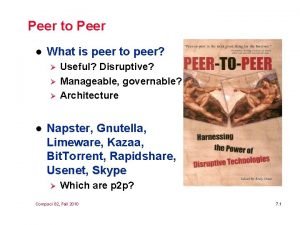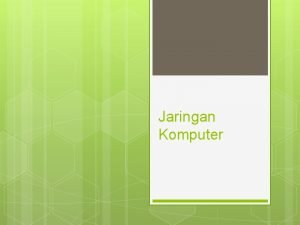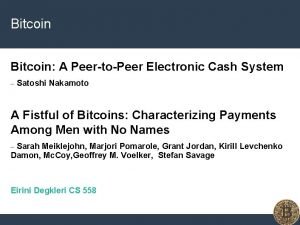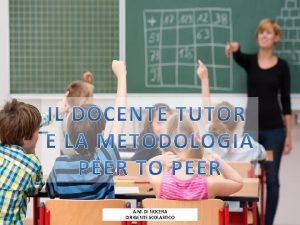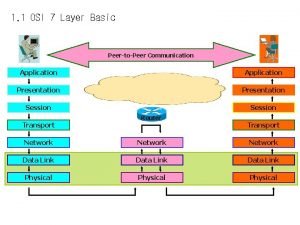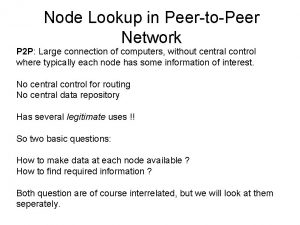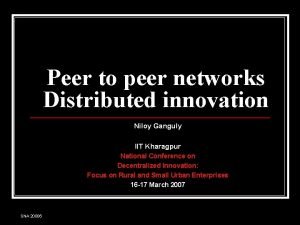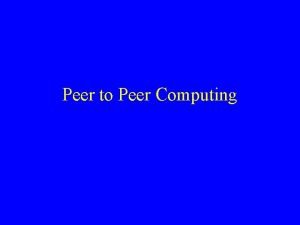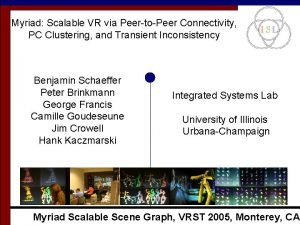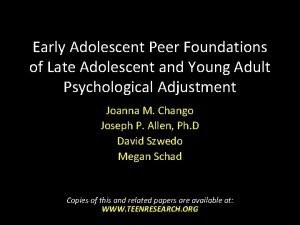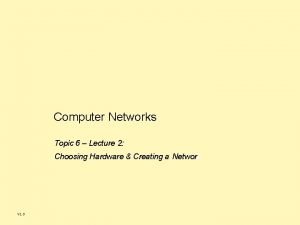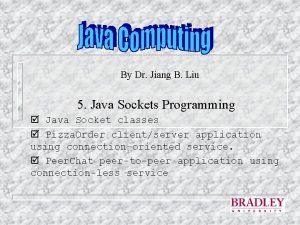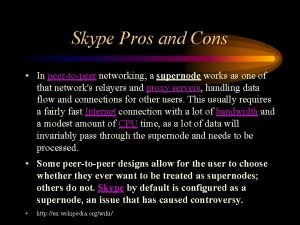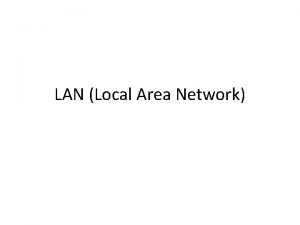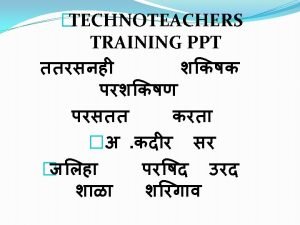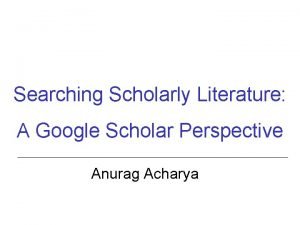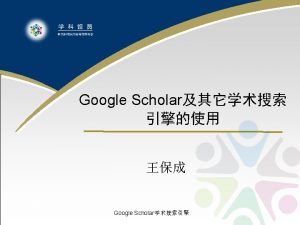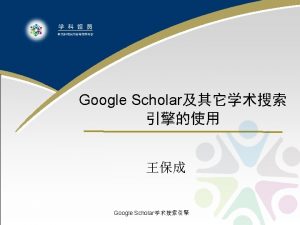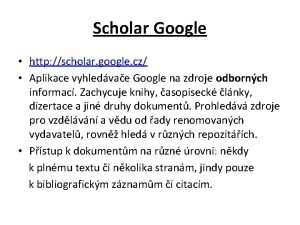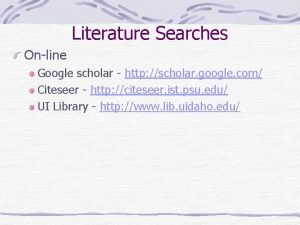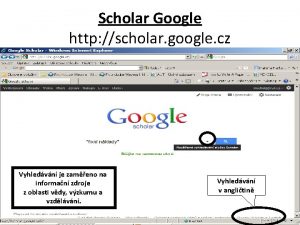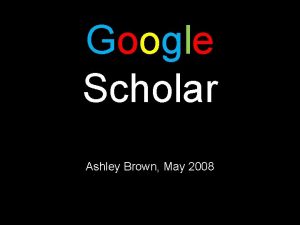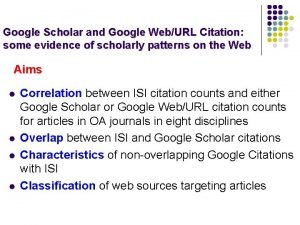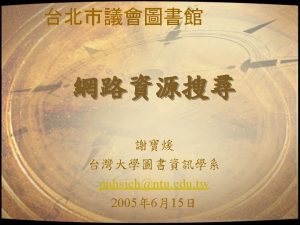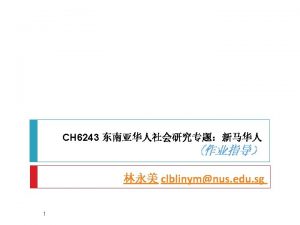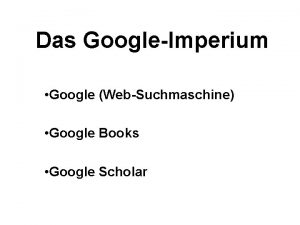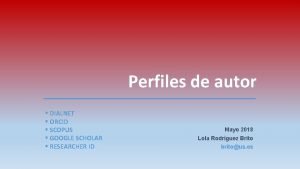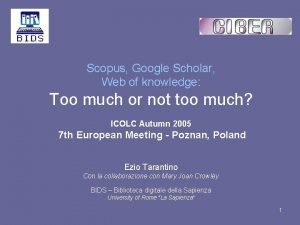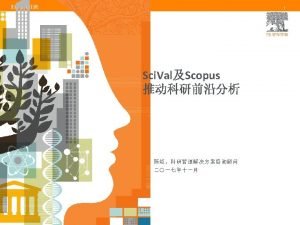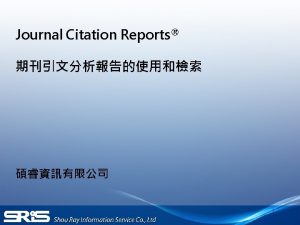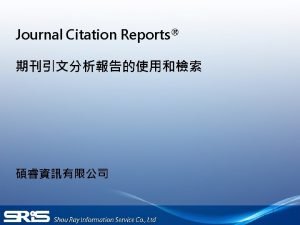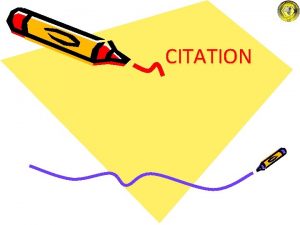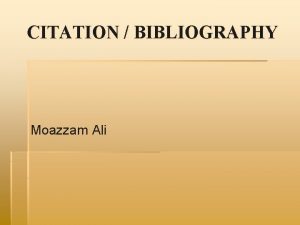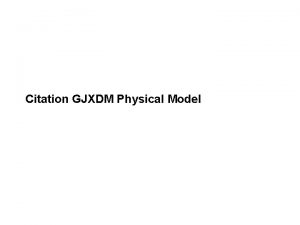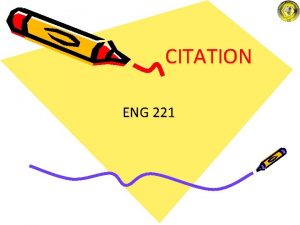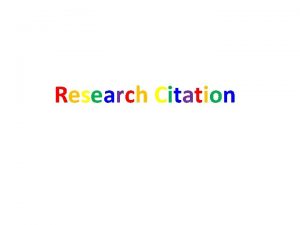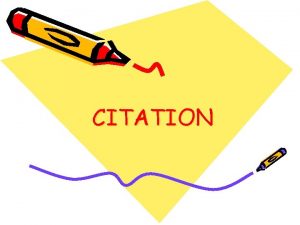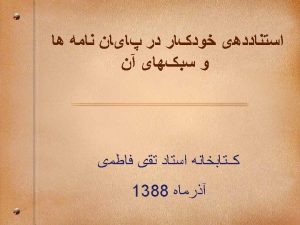Citation metrics versus peer review Google Scholar Scopus



























- Slides: 27

Citation metrics versus peer review: Google Scholar, Scopus and the Web of Science: A longitudinal and cross-disciplinary comparison Anne-Wil Harzing, Middlesex University, London Satu Alakangas, University of Melbourne, Australia

3 An “amateur” in bibliometrics (1): Journal Quality ¡ 1993: Conversation with Head of Department: “How do I know which journals are the best journals, I have no clue? ” ¡ Jan 2000: Bradford Management Centre, UK: ¡ “Why on earth are we using this “stupid” VSNU journal ranking list that ranks my JIBS publication C and all other IB journals D (just like Brickworks, magazine for the building trade). I am sure there are better journal rankings lists around” ¡ July 2000: The first incarnation of my JQL is published on www. harzing. com ¡ 2015: The 56 th edition of the JQL with 18 rankings, >100 ISI cites + 50, 000 page visits/year ¡ 2009: AMLE Outstanding article of the year award for “When Knowledge Wins: Transcending the Sense and Nonsense of Academic Rankings” [most highly cited article in management in 2009] ¡ 2015: AMLE “Disseminating knowledge: from potential to reality – New openaccess journals collide with convention” ¡ How predatory Open Access journals completely distorted Thomson Reuters Highly Cited Academics ranking (see also http: //www. harzing. com/esi_highcite. htm)

4 An “amateur” in bibliometrics (1): Citation analysis ¡ May 2006: University of Melbourne: Promotion application to professor rejected: “you haven’t published enough in Ajournals” ¡ Oct 2006: Publish or Perish v 1. 0 released ¡ Jan 2007: Reapplied for promotion showing my work had more citation impact than that any of the other professors, recent or longstanding ¡ 2010: The Publish or Perish Book, self-published through Amazon Createspace, reviewed in Nature, Scientometrics and JASIST ¡ 2015: 80 th or so release of Publish or Perish, >180 ISI cites, 1. 7 million page visits to date ¡ 26 April 2015: Wharton Research Data Services distributes the Publish or Perish Book at the AACSB conference

5 An “amateur” in bibliometrics (3): publishing in the field ¡ Published a range of papers relating to Google Scholar and Wo. S ¡ Harzing, A. W. ; Wal, R. van der (2008) Google Scholar as a new source for citation analysis? , Ethics in Science and Environmental Politics, 8(1): 62 -71 ¡ Harzing, A. W. ; Wal, R. van der (2009) A Google Scholar h-index for Journals: An alternative metric to measure journal impact in Economics & Business? , Journal of the American Society for Information Science and Technology, 60(1): 41 -46. ¡ Harzing, A. W. (2013) A preliminary test of Google Scholar as a source for citation data: A longitudinal study of Nobel Prize winners, Scientometrics, 93(3): 1057 -1075. ¡ Harzing, A. W. (2013) Document categories in the ISI Web of Knowledge: Misunderstanding the Social Sciences? , Scientometrics, 93(1): 23 -34. ¡ Harzing, A. W. ; Alakangas, S. ; Adams, D. (2014) h. Ia: An individual annual h-index to accommodate disciplinary and career length differences, Scientometrics, 99(3): 811821. ¡ Harzing, A. W. (2014) A longitudinal study of Google Scholar coverage between 2012 and 2013, Scientometrics, 98(1): 565 -575. ¡ Harzing, A. W. ; Mijnhardt, W. (2015) Proof over promise: Towards a more inclusive ranking of Dutch academics in Economics & Business, Scientometrics, 102(1): 727 -749. ¡ Harzing, A. W. (2015) Health warning: Might contain multiple personalities. The problem of homonyms in Thomson Reuters Essential Science Indicators, 105(3): 2259 -2270 Scientometrics.

6 The lesson for academic careers? ¡ If you want something changed: take initiative, you can change things, even as an individual ¡ Being generous can sometimes bring unexpected benefits ¡ I provide many resources for free on my website and spend many hours every week responding to requests for assistance from all over the world ¡ Many academics now know my name, even though they don’t know my research ¡ Be prepared for the inevitable confusion and downright nasty reactions ¡ “It doesn’t work” support requests (no internet connection, wrong searches etc. ) ¡ Enter my publications in your “Harzing system” now! CV attached; you have ruined my career by not including my publication in “your database” ¡ We are going on strike tomorrow because of the Harzing index, everyone hates you ¡ You are discriminating against me because I am not white, your website should be taken down instantly; I don’t understand why you still have a job (I refused personal telephone support after giving extensive email support to an academic who kept maintaining I was wrong and he knew better how Google Scholar worked than I did) ¡ Accept that your “research hobby” can overpower your “real research” ¡ Publishing in another field can be great fun and liberating

7 Increasing audit culture: Metrics vs. peer review ¡ Increasing “audit culture” in academia, where universities, departments and individuals are constantly monitored and ranked ¡ National research assessment exercises, such as the ERA (Australia) and the REF (UK), are becoming increasingly important ¡ Publications in these national exercises are normally assessed by peer review for Humanities and Social Sciences ¡ Citations metrics are used in the (Life) Sciences and Engineering as additional input for decision-making ¡ The argument for not using citation metrics in SSH is that coverage for these disciplines is deemed insufficient in Wo. S and Scopus

8 The danger of peer review? (1) ¡Peer review might lead to harsher verdicts than bibliometric evidence, especially for disciplines that do not have unified paradigms, such as the Social Sciences and Humanities ¡ In Australia (ERA 2010) the average rating for the Social Sciences was only about 60% of that of the (Life) Sciences ¡ This is despite the fact that on a citations per paper basis Australia’s worldwide rank is similar in all disciplines ¡ The low ERA-ranking led to widespread popular commentary that government funding for the Social Sciences should be reduced or removed altogether ¡ Similarly negative assessment of the credibility of SSH can be found in the UK (and no doubt in many other countries)

9 The danger of peer review? (2) ¡ More generally, peer review might lead to what I have called “promise over proof” ¡ Harzing, A. W. ; Mijnhardt, W. (2015) Proof over promise: Towards a more inclusive ranking of Dutch academics in Economics & Business, Scientometrics, vol. 102, no. 1, pp. 727 -749. ¡ Assessment of the quality of a publication might be (subconsciously) influenced by the “promise” of: ¡ the journal in which it is published, ¡ the reputation of the author's affiliation, ¡ the sub-discipline (theoretical/modeling vs. applied, hard vs. soft) ¡ [Promise] Publication in a triple-A journal initially means that 3 -4 academics thought your paper was a worthwhile contribution to the field. But what if this paper is subsequently hardly ever cited? ¡ [Proof] Publication in a “C-journal” with 1, 000+ citations means that 1, 000 academics thought your paper was a worthwhile contribution to the field

10 What can we do? ¡ Be critical about the increasing audit culture ¡ Adler, N. ; Harzing, A. W. (2009) When Knowledge Wins: Transcending the sense and nonsense of academic rankings, The Academy of Management Learning & Education, vol. 8, no. 1, pp. 72 -95. ¡ But: be realistic, we are unlikely to see a reversal of this trend. Hence in order to “emancipate” the Social Sciences and Humanities, an inclusion of citation metrics might help. However, we need to: ¡ Raise awareness about: ¡ Alternative data sources for citation analysis that are more inclusive (e. g. including books, local and regional journals, reports, working papers) ¡ Difficulty of comparing metrics across disciplines because of different publication and citation practices ¡ Life Science and Science academics in particular write more (and shorter) papers with more authors each; 10 -15 authors not unusual, some >1000 authors ¡ Suggest alternative data sources and metrics ¡ Google Scholar or Scopus instead of Wo. S/ISI ¡ h. Ia (Individual annualised h-index), i. e. h-index corrected for career length and number of co-authors ¡ measures the average number of single-author equivalent impactful publications an academic publishes a year (usually well below 1. 0)

11 Need for comprehensive empirical work ¡ Dozens of studies comparing two or even three databases. However: ¡ Focused on a single or small groups of journals or a small group of academics ¡ Only covered a small number of disciplines ¡ Largest study was Delgado-López-Cózar &Repiso-Caballero (2013), but only included a single discipline ¡ Very few studies doing longitudinal comparisons ¡ De Winter et al. (2014): Wo. S and GS 2005 & 2013 for 56 classic articles ¡ Harzing (2014): 2012 -2013 for 20 Nobel Prize winners (GS only) ¡ Hence our study provides: ¡ 2 -year longitudinal comparison (2013 -2015) with quarterly data-points ¡ Cross-disciplinary comparison across all major disciplinary areas ¡ Comparison of 4 different metrics: ¡ publications, citations, h-index ¡ h. I, annual (h-index corrected for career length and number of co-authors)

12 The bibliometric study (1): The basics ¡ Sample of 146 Associate and Full Professors at the University of Melbourne ¡ All main disciplines (Humanities, Social Sciences, Engineering, Sciences, Life Sciences) were represented, 37 sub-disciplines ¡ Two full professors (1 male, 1 female) and two associate professors (1 male, 1 female) in each sub-discipline (e. g. management, marketing, accounting, economics) ¡ Collected data on education, career trajectory, international experience, internal/external promotion, and career interruptions through survey (not reported here) ¡ Citation metrics in Wo. S/ISI, Scopus and Google Scholar ¡ Collected citation data every 3 months for 2 years ¡ Google Scholar data collected with Publish or Perish (http: //www. harzing. com/pop. htm) ¡ Wo. S/ISI and Scopus collected in the respective databases and imported into Publish or Perish to calculate metrics ¡ The final conclusion: with appropriate metrics and data sources, citation metrics can be applied in the Social Sciences ¡ ISI H-index: Life Sciences average lies 200% above Social Sciences average ¡ GS h. Ia index: Life Sciences average lies 8% below Social Sciences average

13 The bibliometric study (2): Details on the sample ¡ Sample: 37 disciplines were subsequently grouped into five major disciplinary fields: ¡ Humanities: Architecture, Building & Planning; Culture & Communication, History; Languages & Linguistics, Law (19 observations), ¡ Social Sciences: Accounting & Finance; Economics; Education; Management & Marketing; Psychology; Social & Political Sciences (24 observations), ¡ Engineering: Chemical & Biomolecular Engineering; Computing & Information Systems; Electrical & Electronic Engineering, Infrastructure Engineering, Mechanical Engineering (20 observations), ¡ Sciences: Botany; Chemistry, Earth Sciences; Genetics; Land & Environment; Mathematics; Optometry; Physics; Veterinary Sciences; Zoology (44 observations), ¡ Life Sciences: Anatomy & Neurosciece; Audiology; Biochemistry & Molecular Biology; Dentistry; Obstetrics & Gynaecology; Ophthalmology; Microbiology; Pathology; Physiology; Population Health (39 observations). ¡ Discipline structure followed Department/School structure at the University of Melbourne ¡ Overrepresentation of the (Life) Sciences and underrepresentation of Social Sciences beyond Business & Economics ¡ Overall, sufficiently varied coverage across the five major disciplinary fields

14 The bibliometric study (3): Descriptive statistics

15

16 Longitudinal results: quarterly % increase in papers per academic in different databases

17 Longitudinal results: quarterly % increase in citations per academic in different databases

Different data-sources between disciplines: number of papers 200 180 160 Number of papers 140 120 100 80 60 40 20 0 Web of Science Scopus Google Scholar Humanities 16 21 93 Social Sciences 30 34 115 Engineering 81 103 143 Sciences 98 101 149 Life Sciences 109 123 189 18

Different data-sources between disciplines: number of citations 5000 4500 4000 Citations 3500 3000 2500 2000 1500 1000 500 0 Web of Science Scopus Google Scholar Humanities 61 100 871 Social Sciences 591 782 2604 Engineering 897 1132 1964 Sciences 2612 2558 3984 Life Sciences 3139 3313 4699 19

Different data-sources between disciplines: number of citations 5000 Citations 4000 3000 2000 1000 0 Humanities Social Sciences Engineering Sciences Life Sciences Web of Science 61 591 897 2612 3139 Scopus 100 782 1132 2558 3313 Google Scholar 871 2604 1964 3984 4699 20

Different data-sources between disciplines: h-index 35, 0 h-index 30, 0 25, 0 20, 0 15, 0 10, 0 5, 0 0, 0 Humanities Social Sciences Engineering Sciences Life Sciences Web of Science 3, 5 9, 6 13, 5 25, 6 27, 1 Scopus 4, 3 12, 0 15, 6 28, 3 Google Scholar 12, 3 21, 5 20, 8 30, 1 33, 4 21

Different data-sources between disciplines: h. Ia index 0, 70 h. Ia index 0, 60 0, 50 0, 40 0, 30 0, 20 0, 10 0, 00 Humanities Social Sciences Engineering Sciences Life Sciences Web of Science 0, 14 0, 32 0, 33 0, 44 0, 43 Scopus 0, 18 0, 42 0, 41 0, 45 0, 46 Google Scholar 0, 36 0, 66 0, 53 0, 57 0, 65 h. Ia: h-index corrected for academic age (to accommodate differences in career length) and number of coauthors (to remove discipline bias) 22

23 Comparing Wo. S h-index with Scopus or GS h. Ia

24 Different data-sources between disciplines: Statistics ¡ For the ISI h-index gender, rank and discipline differences explain nearly 60% of the variance ¡ For GS h. Ia, the explained variance is only 14% ¡ Reduction of differences across levels of appointment ¡ Reduction of differences across disciplines ISI h-index Google Scholar h. Ia Stand. Beta Significance Gender = Female -0. 066 0. 222 -0. 017 0. 822 Rank Professor 0. 361 0. 000 0. 217 0. 006 Humanities -0. 591 0. 000 -0. 356 0. 000 Social Sciences -0. 491 0. 000 0. 020 0. 816 Engineering -0. 357 0. 000 -0. 149 0. 087 Sciences -0. 045 0. 468 -0. 123 0. 178 Adjusted R-square 0. 591 0. 139

25 Quick comparison across disciplines ¡H-index ISI data ¡ Life Sciences vs. Humanities: 27 vs. 3. 5 ¡ i. e. nearly 8 times as high ¡ Life Sciences vs. Social Sciences: 27 vs. 9. 5 ¡ i. e. nearly 3 times as high ¡h. Ia-index GS data ¡ Life Sciences vs. Humanities: 0. 61 vs. 0. 34 ¡ i. e. nearly 2 times as high ¡ Life Sciences vs. Social Sciences: 0. 61 vs. 0. 66 ¡ i. e. 8% lower

26 Individual comparisons for the three databases

27 Conclusion ¡ Will the use of citation metrics disadvantage the Social Sciences and Humanities? ¡ Not, if you use a database that includes publications important in those disciplines (e. g. books, national journals) ¡ Not, if you correct for differences in co-authorships ¡ Is peer review better than metrics (in large scale research evaluation)? ¡ Yes, in a way…. The ideal version of peer review (informed, dedicated, and unbiased experts) is better than a reductionist version of metrics (ISI h-index or citations) ¡ However, the inclusive version of metrics (GS h. Ia or even Scopus h. Ia) is probably better than the likely reality of peer review (hurried semiexperts, potentially influenced by journal outlet and affiliation) ¡ In research evaluation at any level use a combination of peer review and metrics wherever possible, but: ¡ If reviewers are not experts, metrics might be a better alternative ¡ If metrics are used, use an inclusive database (GS or Scopus) and career and discipline adjusted metrics

28 Want to know more? ¡The resulting article has been resubmitted to Scientometrics yesterday after a second round of revisions ¡So hopefully it will be accepted and in press soon ¡Any questions or comments?
 Google acadmico
Google acadmico Annotazioni sulla verifica effettuata peer to peer
Annotazioni sulla verifica effettuata peer to peer Peer-to-peer
Peer-to-peer Peer to peer transactional replication
Peer to peer transactional replication Peer to peer transactional replication
Peer to peer transactional replication Konsep dasar jaringan komputer
Konsep dasar jaringan komputer Registro peer to peer compilato
Registro peer to peer compilato Sviluppo condiviso esempi di peer to peer compilati
Sviluppo condiviso esempi di peer to peer compilati Relazione finale tutor tirocinio esempio
Relazione finale tutor tirocinio esempio Peer to peer l
Peer to peer l Peer to peer merupakan jenis jaringan… *
Peer to peer merupakan jenis jaringan… * Bitcoin: a peer-to-peer electronic cash system
Bitcoin: a peer-to-peer electronic cash system Features of peer to peer network and client server network
Features of peer to peer network and client server network Programmazione e sviluppo condiviso peer to peer
Programmazione e sviluppo condiviso peer to peer Peer-to-peer communication in osi model
Peer-to-peer communication in osi model Peer p
Peer p Node lookup in peer to peer network
Node lookup in peer to peer network Peer-to-peer o que é
Peer-to-peer o que é Peer to peer computing environment
Peer to peer computing environment Peer to peer intervention
Peer to peer intervention Peer-to-peer o que é
Peer-to-peer o que é Peer-to-peer o que é
Peer-to-peer o que é Peer to peer network hardware
Peer to peer network hardware Peer to peer chat application in java
Peer to peer chat application in java Cons of skype
Cons of skype Jaringan peer to peer diistilahkan dengan
Jaringan peer to peer diistilahkan dengan Google google google
Google google google Google scholar
Google scholar
